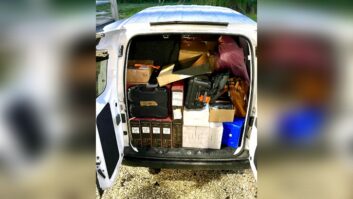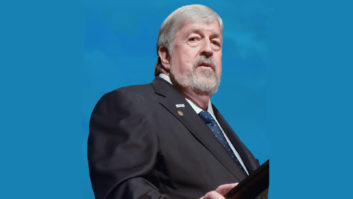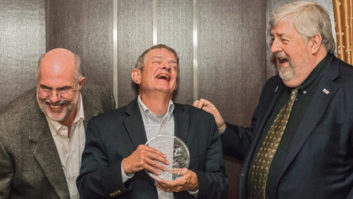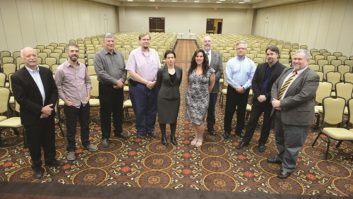The Grassroots Radio Conference is an informal gathering of like-minded community radio station staffers who have met almost every year since 1996. The gathering arose from discussions among a cohort of stations dissatisfied with the general direction of public radio at the time.

Grassroots Radio attendees gather in front of the Maetreum of Cybele. They were particularly concerned about a program that was being recommended by consultants in the late 1990s called “Healthy Stations.” This program encouraged local community radio stations to cut down on volunteer programmers and incorporate more syndicated content. Some stations embraced this approach, which was claimed to guarantee better quality for listeners and more fundraising dollars, but the Grassroots cohort chose to keep their volunteer centered ethos.
Donna DiBianco, a former station manager and current radio start-up consultant, was the lead organizer of this year’s conference. She describes the conference as “a loosely formed coalition of dedicated people from nearly 70 community radio stations who work tirelessly to support similar groups. These outlets have a mission to serve their community with relevant, locally produced programming that generally serves an audience that is historically neglected by mainstream media. Given the influx of stations from the LPFM window, some stations are on a tight deadline and needed the vital startup information shared at this gathering.”
While most professional conferences take place in hotels, the Grassroots Radio Conference usually is hosted in donated spaces at schools, community centers, and once even in a post office that was refurbished to create a media arts center. Attendees often sleep at local volunteer homestays and in tents, and all presenters come on their own dime and make presentations for free. The storytelling that might happen at a Las Vegas bar during NAB Show happens around a campfire for the Grassroots radio stations.

WLPP(FM)
The Grassroots Radio Conference was held this year at the Matreum of Cybele in Palenville, N.Y. The Matreum is the home of WLPP(LP), which has been on the air for just two months. The Matreum is a combination of residential community, temple, library, coffee shop and event space for female and transgendered spirituality. WLPP is also the first Pagan-owned radio station in the United States.
The participants in the Matreum were inspired to build the station by the disastrous floods caused during Hurricane Irene. During that catastrophe, much of the communications infrastructure was knocked out and citizens did not have many options for life saving information. WLPP(LP) wanted to build a station that could be locally focused and provide in-depth reporting for Palenville residents.
Dharma Dailey, a volunteer on the team that launched nearby community radio station WXGC, said, “As we were developing the station, we saw that people needed local information from resilient sources about what roads were closed in their town and where relief efforts were focused, but most media outlets focused on larger urban centers. One station that did a great job was WRIP, where the station stopped regular programming and served as an information hub and emergency broadcaster. We felt every town in the region should have radio stations that were capable of that.”
This year’s GRC had a number of new LPFM stations in attendance. Another new startup is Zumix, an after-school music program for children in east Boston, which currently runs a Web stream.
“Zumix was founded in 1991 as a response to the worst year of youth-on-youth gang violence in Boston,” said Brittany Thomas, the station manager. “Since then, we’ve been using music as a tool to help youth express their ideas about urban life and find alternative ways of addressing anger, fear and misunderstanding.”
The antenna will be hosted on top of a public high school, which will also build a studio and broadcast some hours of student created programming.
When asked about challenges for their project, Thomas said, “We’ll need to figure out a healthy balance between effective youth development and engaging content. While it will continue to be our priority to create a skill-building, supportive media creation process, our more public platform will require us to think more about listeners. And it is a big responsibility to figure out what to say to the world!”

EQUIPMENT AND BUDGETS
Though LPFM stations are non-profit and non-commercial and are generally small, they still need much of the same equipment as a full-power station; suppliers of equipment and content have taken notice of the opportunity. This year’s conference was sponsored by equipment distributors such as SCMS, software and service providers like Spinitron and NPR Distribution’s Content Depot, Austin Airwaves, Pacifica Network, Nautel, Community Radio Goddess and two new companies, Kaatskit and Phantom Machine Works.
The influx of low-power FM groups in recent years has spurred innovations that fit the needs and budgets of these small stations. Some technically oriented participants have even launched companies based on ideas developed for LPFM.
One company such company is Kaatskit (Kaatskit.com), which manufactures broadcast consoles. Kaatskit was started by Al Davis, an engineer and former university electronics professor. The company name reflects its location in the Catskill Mountains and is an homage to the Heathkit electronics kits that Davis built when learning circuit design. The Kaatskit console is modular, allowing the station to switch in different sorts of faders into the frame as the needs of the station change over the life of the station. The console is available fully built or in a kit form at a reduced price for stations that have technically oriented volunteers who can assemble it themselves.
Another new company at the conference was Phantom Machine Works, founded by Todd Wallin and David Klann. This company does turnkey installations and support of the Linux-based automation system Rivendell. Another project in development is a real-time broadcast quality audio processor, dubbed the NABRO, using Linux-based software on a computer with professional soundcards. They are also working on a streaming IP-based studio transmitter link software package with built-in measures for automatic reconnection and resilience.

WORKSHOPS
Many of the volunteer based stations are challenged for resources, and it is unusual for hosts to be paid. What money comes in to stations usually goes to equipment, expenses or certain organizational tasks that are difficult to find volunteers to do, such as accounting and professional services.
David Goodman offered a workshop on how volunteer hosts can make use of the skills they learn in community radio to earn a living as a freelance media creator. For example, Goodman broadcasts his weekly local interview show as a volunteer, but if he finds a story that he thinks is worthy of syndicated attention, he pitches it to various national shows that take pitches from freelance audio producers.
Goodman frequently does “double-enders” — he records broadcast quality interviews for producers in other cities who are talking with their guests over the phone. He also discussed doing recording, narration and editing for various companies, government agencies and non-profits, which need to have educational multi-media produced.
Another workshop focused on energy efficiency for radio stations, taught by Chris Maxwell, founder of WRIR(LP) in Richmond, who is working on supporting several new local groups starting radio stations around Virginia.
“One example I know, there is an LPFM radio station which spends $10,000 per year on electricity, mostly for heating and cooling, when they should spend about $3,000 or less, “ he said. “Save energy before you try to go solar, plug the leaks in your energy bucket before adding energy sources.”
Given that the stations often have little capital, committed volunteers and an interest in green practices, community radio stations often investigate and sometimes can utilize opportunities for energy efficiency first. Solar can happen if the group can afford to invest up front and get lower bills over the long term.
Pete Tridish is a radio engineer and community radio policy advocate with the non-profit station building group International Media Action.











